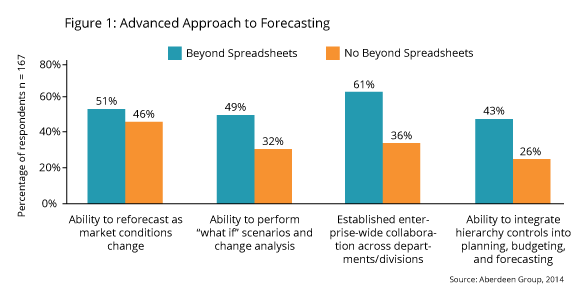Sales Operations ensure the smooth running of the sales team by supporting sales processes and making sure that data is immediately available to decision makers. Sales Ops also plays a strategic role in identifying, proposing and championing new technologies that will improve the efficiency of the sales team.
But like many other parts of the organization, accurate and timely forecasts can come as a challenge, even when it’s one of the most important aspects of Sales Ops planning. The impact of an inaccurate sales or financial forecast can materially affect an organization’s bottom line, and lead to other issues such as effective planning for the next plan year. We’ve outlined three challenges Sales Ops faces when it comes to accurate forecasting.
1. Diverse and Dispersed Organizations
The forecast process requires input from several functions in an organization such as sales, marketing, and finance. Sales Ops has to juggle input from multiple functions, and somehow aggregate everyone’s information and data into one single source of truth. This seems like a lot for one job role, and as an organization continues to grow, establishing an effective and timely forecasting process doesn’t come easily.
With large diverse and dispersed organizations, multiple locations could also mean Sales Ops lacks visibility and oversight into all the different locations. This makes it more difficult to manage and to rollup the forecast in a timely and efficient manner. The longer the forecast process takes, the less accurate the forecast will be.
2. Accurate Data to Set Sales Goals
As a Sales Ops leader, you spend a significant amount of time not only understanding the state of the business but making sure the business is on track. But in order to understand the state of the business, you need to have accurate data to effectively plan and set goals for the next plan year or quarter. If a forecast is informed by stale and old data, the forecast result isn’t going to be as accurate as intended, or worse, it could be catastrophically off.
According to a survey conducted by Experian Data Quality, they found that inaccurate data had a direct impact on the bottom line for 88% of responding companies, with the average company losing 12% of its revenue as a result of it.
Another study conducted by DiscoverOrg found that sales and marketing departments lose approximately 550 hours and as much as $32,000 per sales rep from using bad data.
A solid planning process is critical, but it’s doomed to fail if it’s based on inaccurate, inconsistent or incomplete data. Sales Ops has to ensure the data sources they use are accurate and up-to-date, and also leverage new sales technology to free up some of the responsibility placed on sales teams to keep track of bad data, which in turn frees up their time to sell.
3. Manual Processes and Spreadsheets
There are limitations when generating forecasts from a CRM that will often lead organizations to use a combination of CRM and spreadsheets to run a forecasting process. This leaves Sales Ops with the responsibility to juggle hundreds of different spreadsheets a week and aggregate them with their own logic to reach some type of conclusion. It’s not only possible that there will be errors during this process (various reports suggest 9 out of 10 spreadsheets contain undetected errors), but when models are increasingly complex, errors are more likely to happen no matter how skilled the user. If the goal is to create an accurate forecast, spreadsheet errors are particularly unwelcome because they don’t provide the insight for proper planning.
Spreadsheets also don’t maintain or promote a process because spreadsheets aren’t a process. They are likely managed through emails, which isn’t a process tool either. One of the core responsibilities of Sales Ops is to improve sales processes and efficiencies, and all in all, it’s hard to run an efficient process without the right tools.
For Sales Ops leaders, forecasting also comes down to timeliness and how time-consuming the process can be. Manual processes don’t give Sales Ops the ability to automatically rollup forecasts for example. This means their time could be better spent elsewhere, but most of their time is probably spent on reactive operational tasks rather than proactive strategic planning. The right solution will give Sales Ops the insight and visibility they need, and also take back the time they have been losing to spreadsheets and manual processes.
“Beyond Spreadsheets” Approach
Some of the difficulties listed above has led Best-in-Class organizations to take what is called a “beyond spreadsheets” approach to tackle issues created by spreadsheets and opt for an approach that utilizes technology and advanced forecasting requirements. Best-in-Class organizations perform higher when they take a “beyond spreadsheets” approach and use sales technology to improve their forecasting process and capabilities.
 How Much Time Do You Spend on the Forecast?
How Much Time Do You Spend on the Forecast?
At Vortini the question isn’t–how much time are you spending on the forecast?
The question really is–why are you spending so much time on the forecast?
Try out our sales forecasting calculator to find out how much time you and your team spend on the forecast.
Jess is a communications professional and Vortini’s lead content/web developer. Her current interests lie in the intersection of sales technology and machine learning. In her free time she reads a book-a-week, practices yoga, and is an avid gardener.

